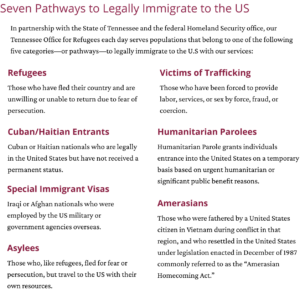

Learn more at the Tennessee Office for Refugees
Is a refugee different from an asylum-seeker?
They both must demonstrate that they have experienced persecution or have a well-founded fear that they will be persecuted “on account of race, religion, nationality, membership in a particular social group, or political opinion.” Migrating people in these two categories’ are eligible to apply for a green card after one year.
- Asylum is granted to people who are already in the United States.
- Refugee: Provided to people who are vetted abroad and approved for resettlement through the federal Office of Refugee Resettlement (ORR) and Homeland Security. A refugee is always an immigrant, but an immigrant is not always a refugee. A refugee is not an illegal immigrant.
What is “illegal” immigration and how is it different from legal immigration?
“The unauthorized resident immigrant population is defined as all foreign-born non-citizens who are not legal residents. Most unauthorized residents either entered the United States without inspection or were admitted temporarily and stayed past the date they were required to leave. . .” – United States Department of Homeland Security
Illegal immigration is a serious offense which results in many consequences such as deportation, loss of residency status, possible ban on re-entry in the future, etc. In Catholic Charities, Diocese of Nashville we always respect the law and only support the legal immigration of our foreign-born neighbors.
An individual may obtain lawful permanent resident status (LPR status), including:
- Family-based visas
- Employment visas
- Fiancé or marriage-based avenues
There are also humanitarian programs that aid individuals in need, such as:
- Temporary Protected Status (TPS)
- Humanitarian Parole
- Refugee
- Asylum
There are different requirements which must be met when an individual applies for these types of visas and immigration avenues. The person is also required to satisfy other requirements over time, including good conduct.
The United States is often described as a nation of immigrants. Except for Native Americans, most Americans are immigrants or the descendants of immigrants or enslaved people. This diversity has been celebrated for its contributions to American culture through cuisine, language, and the arts, among many other influences.
According to the White House website, immigrants also make an important contribution to the U.S. economy. Specifically, immigration boosts economic production by increasing the size of the workforce and productivity. “Far from crowding out native-born workers and depressing their wages, well-educated, entrepreneurial immigrants do much to create and support employment for Americans” (Brookings, 2011).
See why economists Gaetano Basso and Giovanni Peri find that immigrants are more mobile than natives in response to local economic conditions, which helps to labor markets to function more efficiently.
On the other hand, its proven by economists Jennifer Hunt and Marjolaine Gauthier-Loiselle that immigrants boost innovation—a 1 percentage point increase in the population share of immigrant college graduates increases patents per capita by 9 percent to 18 percent, see here.
- Sharing the gains of migration: https://www.worldbank.org/en/topic/migration/overview#:~:text=An%20estimated%20286%20million%20people,by%20the%20end%20of%202021.
- To understand why immigrants without status pay taxes, and the differences between SSN and ITINs: https://www.irs.gov/pub/irs-utl/20-Immigration%20and%20Taxation.pdf
- According to the Department of Homeland Security (DHS), it’s proven that lawful pathways work, and we should support them: https://www.dhs.gov/news/2023/07/25/fact-sheet-data-first-six-months-parole-processes-cubans-haitians-nicaraguans-and
286
million people live outside of their countries of birth, including 32.5 million refugees as of mid-2022. –The World Bank Group (Migration, 2022)
